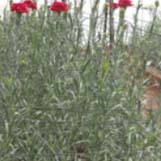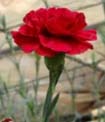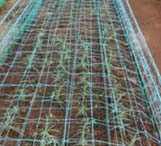cultivation practices
-
soil & climate
Mild climate with a temperature ranging from 10-240C is considered to be the ideal for carnation crop. It is a quantitative long day plant which requires 12 hours sun light for flowering. Humidity in the range of 50-60% is considered very favorable for growth of plant as well as flower development. The CO2 enrichment in polyhouse up to 500-1000 ppm improves the flower quality. The crop requires a well drained and aerated rich sandy loam soil with the optimum pH of 5.5-6.5 and EC ranges from 1.2 - 1.5.
-
propagation
Annual carnation are propagated through seeds and perennial carnations through cuttings. Perpetual flowering carnation are propagated through terminal cuttings. Terminal cuttings of 10-15 cm with 4-leaves are taken from the side shoots and raised in mist chamber or plastic low tunnel. The cuttings should be healthy, free from pest & diseases, it requires a month for sufficient root development. Coir-pith, coco-peat and perlite mixed with soil and sand in different proportions are used as potting media. Stock plants established during October starts yielding cuttings from January and yields about 20-24 cuttings till April. Hormone treatment with 500 ppm NAA ppm, 200 ppm IAA and 500 ppm IBA promotes rooting.
-
Bed preparation and planting
Raised bed of 30-45 cm height, 90-1.0 m width and convenient length with 50 cm foot path are prepared for planting. Media sterilization can be done with application of 30 g/m2 of Basamid, which controls nematodes, weeds, soil borne fungi, bacteria and insects.
Standards can be planted during January to September and spray types during May or August to September with supplemental light and CO2. The bed should be moderately wet and drenched lightly with a fungicide (copper oxychloride or copper hydroxide @ 2 g/L) before planting. -
irrigation

Irrigation immediately after planting is essential and misting has to be done for at least two weeks. Drip laterals have to be laid out every alternate row and emitters are spaced at 30 cm intervals. Fully grown carnation plants require 4-5 litres of water/m2/day. The irrigation water quality in terms of EC and pH should be checked periodically.
-
nutrient management

The deficiency of one or more of the major nutrients limits plant growth and flowering. The application of nutrients in small doses but more frequently favours better growth and flower production. Grow-bag system is a recent innovation in carnation cultivation.The bags are filled with inert growing media like cocopeat are used for planting.
-
support nets

Standard and spray carnation requires support for their entire growth period to produce upright long stems. Four to five layers of nets are laid for protection. Plastic or metal wire with mesh of 7.5 x 7.5 cm are used as first layer followed by 10 x 10 cm, 12.5 x 12.5 cm and 15 x 15 cm. For every 2.5 to 3.0 m, the wires are supported with poles. First net should be fixed at 12 cm above soil and the remaining nets over first net at 15 cm apart.
-
Harvesting and yield
After planting, it takes 110-120 days for peak flowering, the flowers mature in 4-5 months period. It is harvested at tight bud stage and paint brush stage for distant markets and semi open stage for short distance market. Sprays are harvested when at least 2-3 top flowers have opened and other buds show colour.The yield of the carnation depends upon the cultivar, growing region, planting time etc. Standard carnations produce on an average 8-12 flowers/plant and 300-350 flowers m2/year & spray carnations produce 250 flowers/m2/year.

 Carnation
(Dianthus caryophyllus L.) belongs to the family
Caryophyllaceae. It is a herbaeceous perennial flowering
plant with wide range of colours, forms, excellent
keeping quality, ability to withstand long distance
transportation and rehydrate after continuous shipping.
It is used for bedding, pots, edging and rock gardens.
Spray type of carnation are used for flower arrangements
and decorations.
Carnation
(Dianthus caryophyllus L.) belongs to the family
Caryophyllaceae. It is a herbaeceous perennial flowering
plant with wide range of colours, forms, excellent
keeping quality, ability to withstand long distance
transportation and rehydrate after continuous shipping.
It is used for bedding, pots, edging and rock gardens.
Spray type of carnation are used for flower arrangements
and decorations.